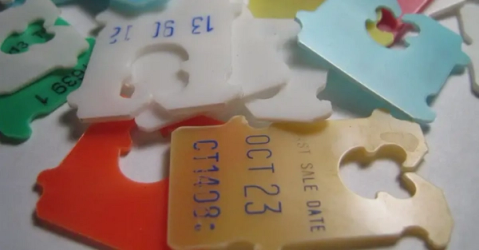Ever noticed the loaves of bread on the grocery store shelf are color-coded?
That’s right, the plastic tags or metal ties that ultimately get tossed in the trash or shoved into your junk drawer indicate the day of the week on which each loaf was baked and packaged. Bread is typically delivered to the stores 5-7 times a week so no matter the tag color you can feel confident that you will find a fresh loaf to enjoy!
Snopes reminds us that we, as consumers, do not need to worry about these tag colors as ”Bread is not kept on the shelf for longer than a couple of days” and different (bread) producers each use their own systems rather than some industry-wide standard.” The true value of color-coding inventory is providing a quick visual reference to help the people who stock the shelves easily recognize and pull outdated stock as they replace it with fresh product.
The same concept can be applied to managing EMS supplies and medications. Color-coded inventory control labels can provide visual cues as to “freshness” and prompt for “spring cleaning” inspections, date checks or stock rotation. We recommend rotating your color choice periodically so that it has meaning and helps your crew identify the old vs the new items.
Let’s start by discussing your end goals to determine what items you want to differentiate and where this visual cue would be most helpful. With multiple color options available for sealing compartments or bags/boxes, medication labels, and consumable inventory tags here are three separate color-coding use cases to consider.
1. Improve Stock Rotation with Supply Tags
If you tag consumable supplies, you can clearly identify older inventory from new inventory by changing colors periodically. This is not only helpful for items that expire, but even for supplies without a defined expiration date can be included in batch color coding to easily see which items have been in your inventory longer than others.
Consider an appropriate time frame for switching colors that will help you clearly determine which items still in circulation should get used to avoid potential waste. Don’t do it too frequently or you may end up with a bag of skittles.
2. Prompt Inspection based on Seal Color
There are a few different options to consider with seal colors. First, use a single color of cabinet/bag/box seal and then change that seal color you use at a specified time to quickly identify items sealed with the previous color. This is a great visual prompt to break older seals to inspect cabinet contents and then reseal with the current color.
Another option is to assign seal colors to specific people to track their involvement in the inspection process. This may be more achievable within a logistics department with a limited number of individuals vs assigning colors to all field personnel. Both options give a clear indicator of inspection status and updates freshly sealed kits, bags or cabinets.
3. Segment to Quickly Identify Different Types of Inventory
Tag certain items with a unique color to help distinguish them apart from one another easily. This can be helpful with vials of controlled substances, multiple sizes of catheters & needles or various concentrations of Epi that may look very similar in their packaging.
You can also use this methodology for specific items used for an event or crisis, like COVID-19, supplies to quickly identify necessary items are available for a periodic or ongoing purpose. You may find it helpful to group items by use in the field or practical patient care.
If you seal your cabinets to expedite inspections, track your narcotics individually or use RFID tags to track your consumable supplies, why not consider incorporating color as part of your inventory management process? This can be just another way to streamline operations to ensure everyone has what they need when and where they need it! Let us know how Operative IQ can help.
Visit the Inventory and Asset Management page to learn more.

